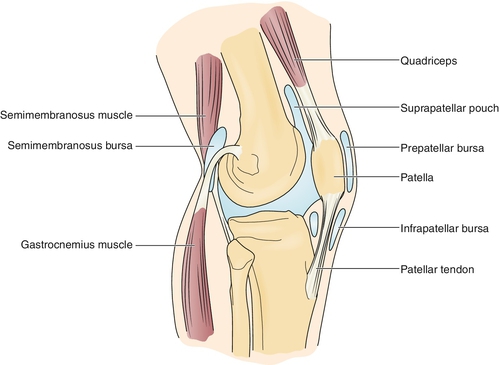CHAPTER 71
Knee Bursitis
Ed Hanada, MD; Florian S. Keplinger, MD; Navneet Gupta, MD
Definition
Knee bursitis is an inflammation of any bursa in the region of the knee joint and is a common clinical disorder that may lead to functional difficulties. Eleven bursae are found within this region (Fig. 71.1) [1]. Three bursae communicate with the knee joint: quadriceps or suprapatellar, popliteus, and medial gastrocnemius. Four bursae are associated with the patella: superficial and deep prepatellar, and superficial and deep infrapatellar. Two are related to the semimembranosus tendons, and two are related to the collateral ligaments of the knee (one of which is under the pes anserinus, or the conjoined tendons of the sartorius, gracilis, and semitendinosus muscles) [1].

In the popliteal fossa, a bursa is located between the medial head of the gastrocnemius and semimembranosus tendon. Swelling in this area is also called Baker cyst and may actually be due to other inflammatory or degenerative conditions (see Chapter 64). For this chapter’s purpose, discussion is limited to knee bursitis arising from inflammation of the previously mentioned bursae.
The most common knee bursitis conditions are the following.
Prepatellar bursitis (housemaid’s knee) is caused by direct trauma, such as falling on a bent knee or frequent kneeling on a hard surface [1]. A case of a massive prepatellar bursitis from chronic crawling as a means of household ambulation in an adult man with cerebral palsy has been reported [2]. In 376 subjects with knee pain and radiographic evidence of knee osteoarthritis, 3.1% had evidence of prepatellar bursitis on magnetic resonance imaging [3].
Infrapatellar bursitis (vicar’s knee) is usually due to repetitive knee flexion in weight bearing, such as deep knee bends, squatting, or jumping; it can be associated with patellar-quadriceps tendinitis [4,5]. In 376 subjects undergoing routine magnetic resonance imaging who had knee pain and radiographic evidence of knee osteoarthritis, 10.6% had evidence of superficial infrapatellar bursitis [3].
Anserine bursitis is commonly seen in overweight older women who also have osteoarthritis of the knees and in individuals who participate in sports that require running, side-to-side movement, and cutting [5,6]. In a study involving persons with a symptomatic knee presenting to an orthopedic clinic with suspected internal knee derangement who had magnetic resonance imaging, only 2.5% of these patients had radiologic evidence of pes anserine bursitis, with no gender preference [7].
Medial collateral ligament bursitis refers to inflammation of a bursa located between the deep and superficial parts of the medial collateral ligament [5]. It has been associated with degenerative disease of the medial joint compartment, with marginal osteophytic spur formation [8]. Furthermore, this bursitis may be seen in equestrian and motorcycle athletes because of the friction applied to the medial side of the knee [8].
Semimembranosus bursitis is usually seen in runners and may be associated with hamstring tendinitis [4]. This was seen in 4.4% of symptomatic subjects undergoing routine magnetic resonance imaging [3].







